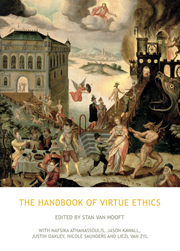Book contents
- Frontmatter
- Contents
- Acknowledgements
- 1 Introduction
- PART I NORMATIVE THEORY
- PART II TYPES OF VIRTUES
- 14 What virtues are there?
- 15 Intellectual virtues
- 16 Virtue, reason and wisdom
- 17 Integrity
- 18 The ends of courage
- 19 Wit
- 20 Humility, Kantian style
- 21 Love, sex and relationships
- 22 Forgiveness and forgivingness
- 23 The virtue of justice revisited
- 24 The virtues of African ethics
- 25 Classical Confucianism as virtue ethics
- 26 Ethics and virtue in classical Indian thinking
- 27 Mindfulness, non-attachment and other Buddhist virtues
- 28 Virtue in Islam
- PART III APPLIED ETHICS
- PART IV THE PSYCHOLOGY OF VIRTUE
- Contributors
- References
- Index
26 - Ethics and virtue in classical Indian thinking
from PART II - TYPES OF VIRTUES
- Frontmatter
- Contents
- Acknowledgements
- 1 Introduction
- PART I NORMATIVE THEORY
- PART II TYPES OF VIRTUES
- 14 What virtues are there?
- 15 Intellectual virtues
- 16 Virtue, reason and wisdom
- 17 Integrity
- 18 The ends of courage
- 19 Wit
- 20 Humility, Kantian style
- 21 Love, sex and relationships
- 22 Forgiveness and forgivingness
- 23 The virtue of justice revisited
- 24 The virtues of African ethics
- 25 Classical Confucianism as virtue ethics
- 26 Ethics and virtue in classical Indian thinking
- 27 Mindfulness, non-attachment and other Buddhist virtues
- 28 Virtue in Islam
- PART III APPLIED ETHICS
- PART IV THE PSYCHOLOGY OF VIRTUE
- Contributors
- References
- Index
Summary
INDIAN ETHICS
Indian thinkers, like their counterparts elsewhere, recognized morality's pervasiveness throughout human life and culture, and did not shy away from enquiry into the nature of morality, right and wrong, and good and bad. On the side of “good” they placed such values as happiness, health, survival, progeny, pleasure, calmness, friendship, knowledge and truth. The “bad” were, more or less, opposites or disvalues: misery, suffering, sickness, injury, death, barrenness, pain, anger, enmity, ignorance, error and untruth. These positive and negative qualities are universalized, in principle at least, for all sentient beings, for it was felt that the highest good (summum bonum) is possible when the whole world can enjoy the good things that the cosmos has to offer.
Reflecting upon the meaning or applications of these judgements has been the way of bringing theory to bear upon the time-worn practices intended to yield the highest good. These may extend from ritual performances and collective desires to affective responses to challenging situations from their surroundings. In much of Indian philosophy, the beginning point is not discursive theorizing on first principles, axiomatic propositions, rational intuitions and so on. Rather, the starting point is the practices that are embedded or grounded in all human cognitive, affective, social-political and even aesthetic efforts. Over time these practices come to be embodied in a tradition and only then in comprehensive doctrines, or articulated first in oral and later in written texts foreshadowed by, and prefiguring, other scriptural texts.
- Type
- Chapter
- Information
- The Handbook of Virtue Ethics , pp. 294 - 305Publisher: Acumen PublishingPrint publication year: 2013



